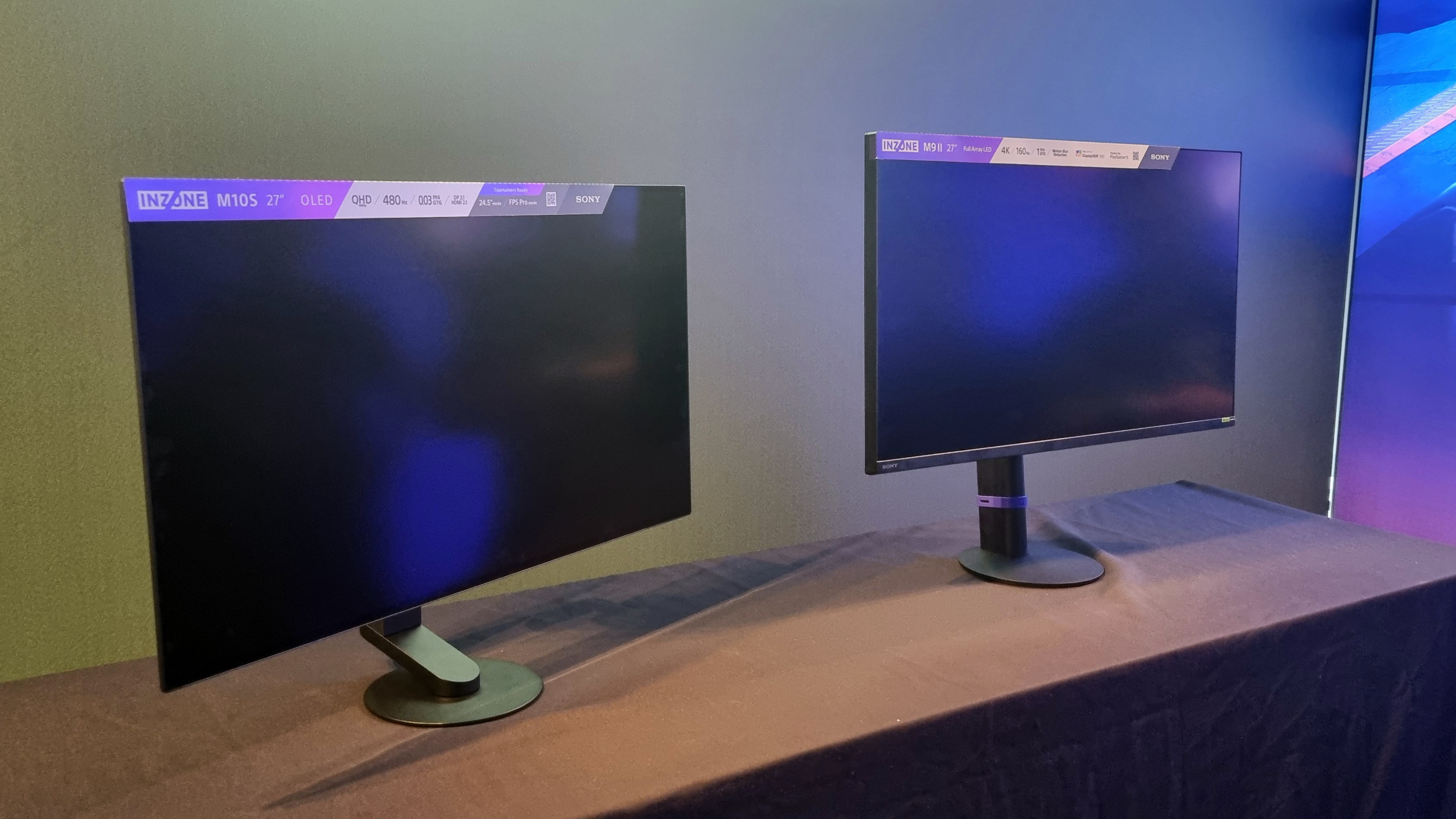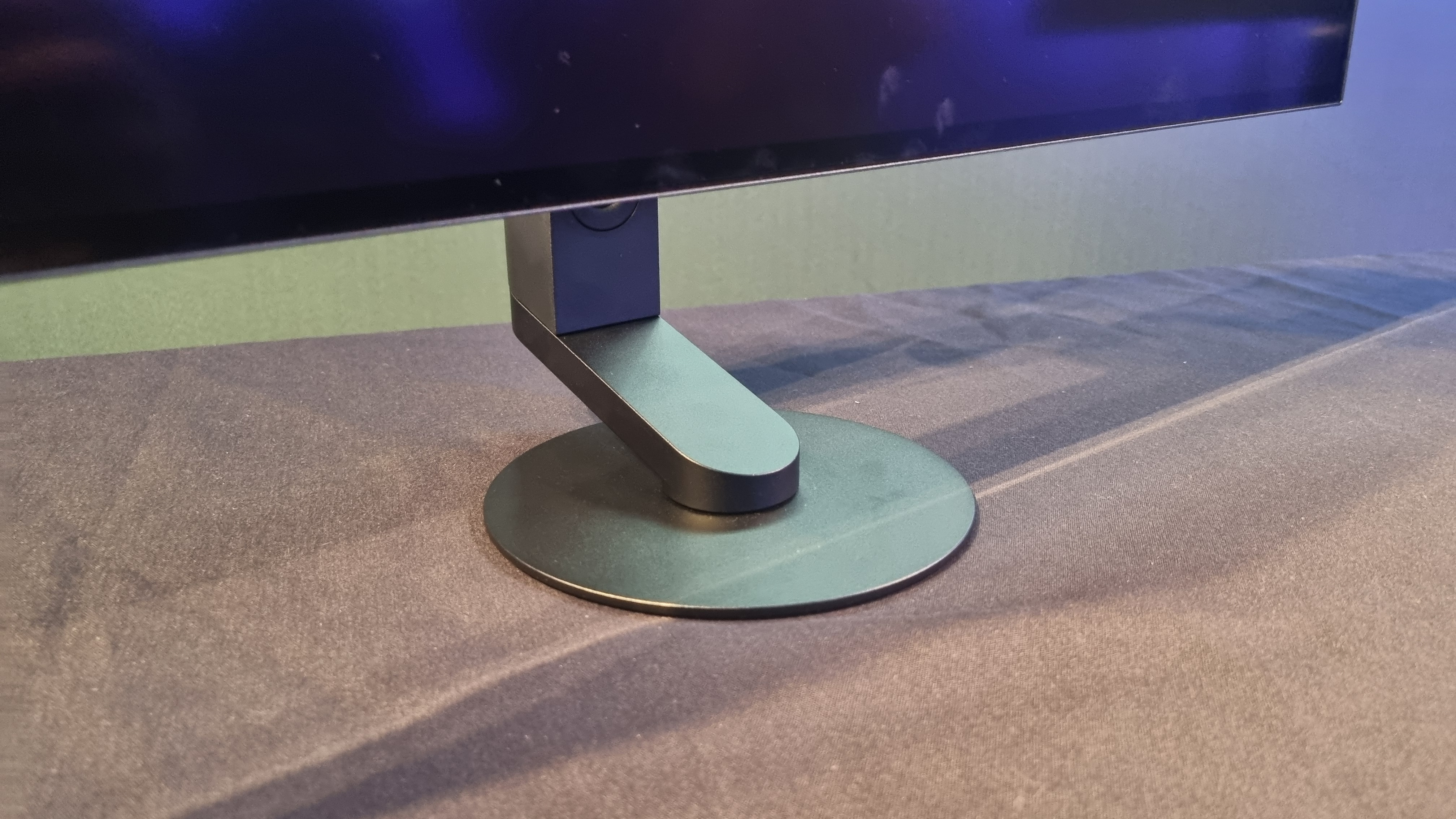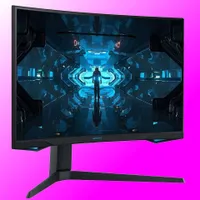Sony's speedy new Inzone gaming monitors feature trick stand designs that resolutely defied my attempts to knock them over
But the pricing? I'm not so convinced.

Gaming monitors can be much of a muchness when it comes to design. While you'll occasionally find the odd ill-advised logo projector, or perhaps some hidden ports in the base, really they all look mostly the same once you look beyond the panels themselves.
The Sony Inzone M10S and Inzone M9 II, however, bring something a little different to the party. What comes into contact with your desk is a small, circular plate designed to take up as little footprint as possible. This is so gamers can happily move their keyboards, mice, and other desk detritus into whichever position is most comfortable, without the monitor stand getting in the way.
That being said, with such a small base design, I couldn't help but think they looked precariously close to falling over. At the product demonstration, I was invited to wobble them, knock them around, and test the stability of what looked suspiciously like an ineffective (if pretty) stand design. In practice, however, they really are much more stable than I was expecting, thanks to a clever bit of mechanical engineering.
The center of gravity is actually right behind the panel, meaning that all the weight is centered in a straight line going down to the middle of the base. They're a bit like Weebles—you can wobble them, but the second you let go they want to return to their upright position almost immediately. Clever, that.
In terms of specs, the Inzone M10S isn't just a pretty stand. It's a 27-inch 1440p OLED panel with up to a 480 Hz refresh rate, 98.5% DCI-P3 coverage, a 1,300 nits peak brightness rating and a host of esports ready features.

That includes a 24.5-inch "professional mode" that reduces the displayed image down to a smaller size. Several assembled esports pros from the Fnatic esports team (which Sony collaborated with to help design the display) explained this was because 24-inch monitors are the default size for competitions, so you can practise your skills on the same-sized screen as the professionals before taking to the big stage.
In fact, the whole ethos here seems to be esports, esports, esports. There's several different monitor modes available, designed to help you gain a competitive edge, including dedicated FPS modes tuned by Fnatic members to better display certain colour contrasts in games like Valorant. I was shown a green fog effect in-game where, on the default setting, a character in the distance began to blend into the smoke. With the FPS Pro+ mode on, however, you could just about make out an elbow amid the mist, giving the game away as to where your opponents may lie.
Keep up to date with the most important stories and the best deals, as picked by the PC Gamer team.
Sounds silly, I know. But I am reliably informed that, when it comes to esports competition, every little advantage helps. And who was I to doubt the superheroes of gaming around me, I guess. I'm just a mere mortal, after all.
For the more sedate gamer (and I'm including myself here), the Sony Inzone M9 II is likely more up your street. It's a 27-inch 4K IPS display with a 160 Hz refresh rate and a 1 ms GTG response time, also featuring that self-balancing stand design. It looked good in action, but I have to say, sticking it next to an OLED of the same size really did throw into direct contrast just how much nicer a good OLED looks compared to even an excellent IPS panel.

The Inzone M9 II is a good-looking display, there's no doubt, but that OLED really did look stunning in a dimly lit conference room. More than that, the 480 Hz refresh rate looks smooth as glass under gameplay conditions, and it did make me slightly envious of high refresh rate displays in comparison to my own, lesser monitor at home.
| Row 0 - Cell 0 | Inzone M9 II | Inzone M10S |
| Panel size | 27-inch | 27-inch |
| Max resolution | 4K | 1440p |
| Max refresh rate | 160 Hz | 480 Hz |
| Response speed | 1 ms GtG | 0.03 ms GtG |
| Colour | DCI-P3 95% | DCI-P3 98.5% |
| Brightness | 750 nit | 1300 nit |
| Interface | DisplayPort 2.1, HDMI 2.1 x 2, USB hub | DisplayPort 2.1, HDMI 2.1 x 2, USB hub |
| Price | $799 | $1,099 |
Two premium-looking monitors then, with some clever features that make them stand out from the pack—and some seriously high refresh rates to boot. All that was left to discuss was the price, and I have to admit that when it was revealed, I performed a double take. Let me start out by saying, the Inzone M9 II is $100 cheaper than the Inzone M9 before it, which was a welcome surprise.
The bad news? It's $799. That's a substantial amount for a 27-inch 4K 160 Hz monitor, and while it certainly looked lovely, when something like the fantastic LG Ultragear 27GR93U retails for $630, I can't really see why you'd pick the Sony instead. That stand's great and all, but for that sort of money I'd want something that was going to blow me away, and in my brief time with it I couldn't quite figure out where the money had gone.

As for the OLED Inzone M10S? That'll set you back $1,099. We still expect OLED monitors—particularly ones with mega fast refresh rates and esports credentials—to command the big bucks, so it came as less of a shock. Still, that's a serious chunk of change for any 27-inch display.
In person, those trick stands really did impress, and the M10S was a delight to look at in action. But with prices like this, I can't help thinking that, unless you really are looking to maximise your performance to the nth degree, you're likely paying extra for the Sony branding and the Fnatic association here. 480 Hz refresh is a nice thing to have, but for this kind of money? It's a serious amount to spend.
We'll be testing them to find out how they perform under the microscope, but one thing's for sure—they're going to have to work hard to justify all that moolah.
Best gaming monitor: Pixel-perfect panels.
Best high refresh rate monitor: Screaming quick.
Best 4K monitor for gaming: High-res only.
Best 4K TV for gaming: Big-screen 4K PC gaming.

Andy built his first gaming PC at the tender age of 12, when IDE cables were a thing and high resolution wasn't—and he hasn't stopped since. Now working as a hardware writer for PC Gamer, Andy spends his time jumping around the world attending product launches and trade shows, all the while reviewing every bit of PC gaming hardware he can get his hands on. You name it, if it's interesting hardware he'll write words about it, with opinions and everything.


